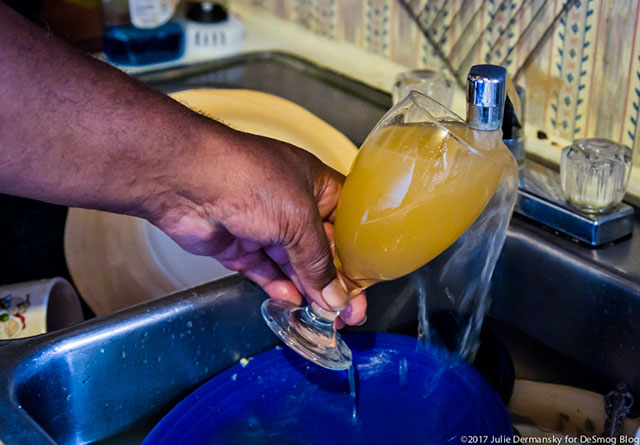
For years the discolored water delivered to the northern Louisiana delta town of St. Joseph resembled what one would expect to find in a third-world country. But it wasn’t until high levels of lead were discovered in the town’s municipal water system that work began to replace it.
On March 6, Louisiana Gov. John Bell Edwards, along with local officials and state lawmakers, attended a groundbreaking ceremony for St. Joseph’s new water system, wielding symbolic golden shovels in the parking lot next to city hall.
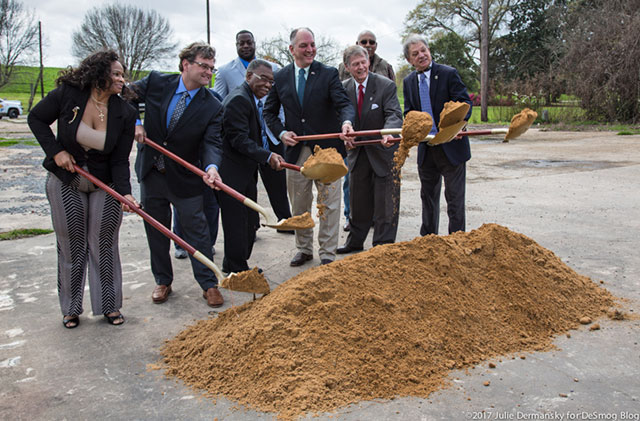 Gov. John Bell Edwards, front and third from right, at the groundbreaking ceremony in St. Joseph, Louisiana, for the new municipal water system. (Photo: Julie Dermansky)
Gov. John Bell Edwards, front and third from right, at the groundbreaking ceremony in St. Joseph, Louisiana, for the new municipal water system. (Photo: Julie Dermansky)
After tests found lead in the water of city hall and some of the town’s homes, Gov. Edwards made an emergency health proclamation on December 16, 2016, enabling a fast-tracked replacement of St. Joseph’s water system.
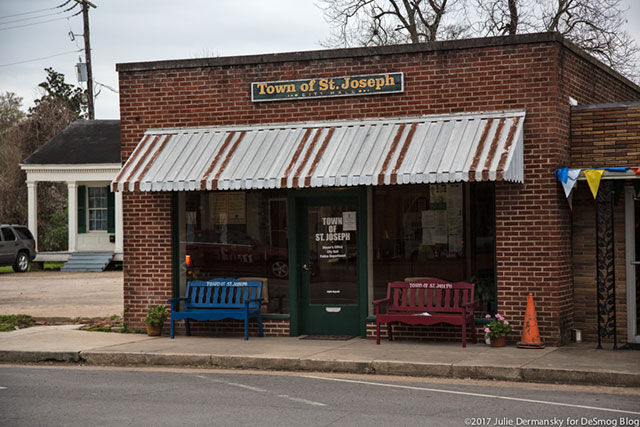 St. Joseph, Louisiana, City Hall. (Photo: Julie Dermansky)
St. Joseph, Louisiana, City Hall. (Photo: Julie Dermansky)
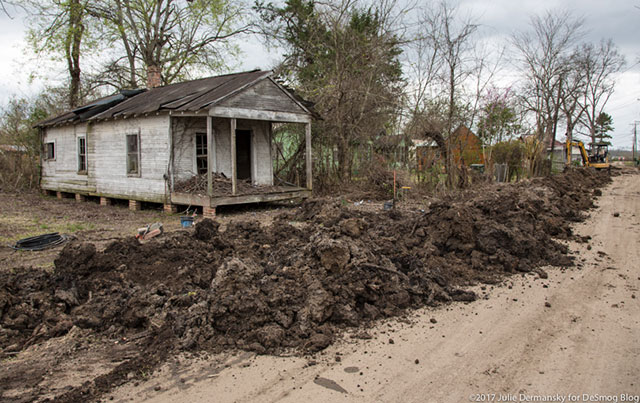 Street in St. Joseph where construction to replace the municipal water pipes is underway. (Photo: Julie Dermansky)
Street in St. Joseph where construction to replace the municipal water pipes is underway. (Photo: Julie Dermansky)
The state began making three liters of water per day available for each of the town’s residents. It also came up with $8 million in funding and expedited the project to replace the municipal water system, which is expected to be operational by September.
For the majority-African American town of some 1,100 people, relief from the ongoing water crisis couldn’t come soon enough. For almost a decade, residents, 33 percent of which live in poverty, have complained about the discolored, dirty water that comes out of their taps.
State-issued bottled water has been replaced with potable water in large storage tanks, known as “water buffaloes,” stationed around town, where residents can fill up containers with water.
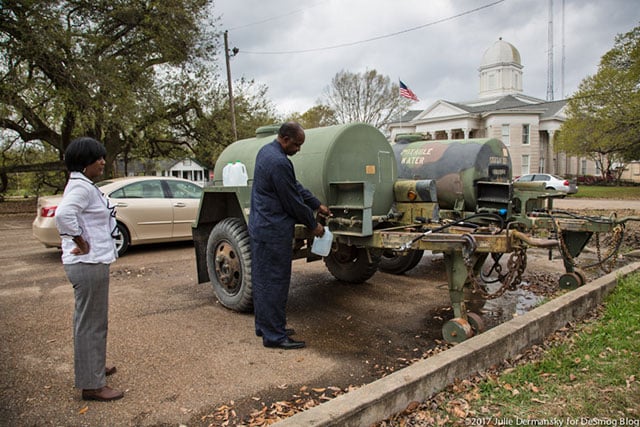 Wanda and Roy Bowman, both local ministers in St. Joseph, collecting clean water to deliver to their neighbors who are not able to gather it themselves. (Photo: Julie Dermansky)
Wanda and Roy Bowman, both local ministers in St. Joseph, collecting clean water to deliver to their neighbors who are not able to gather it themselves. (Photo: Julie Dermansky)
There have been noticeable improvements to the existing water system since the governor’s office stepped in, including lessening water discoloration. But for many, the water coming out of their faucets is still a shade of yellow or brown, making washing anything impractical, even though it has been deemed safe to do so.
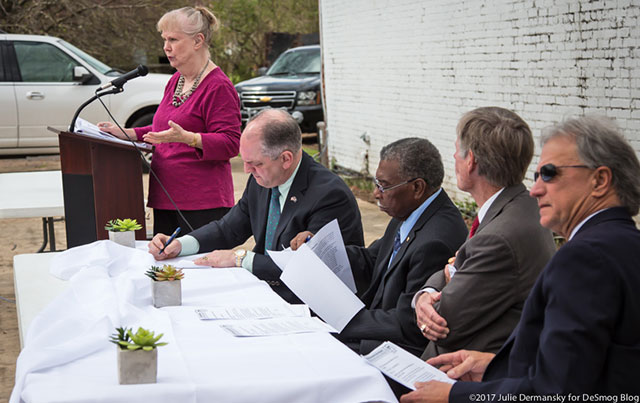 Environmental scientist Wilma Subra speaking during the ground breaking ceremony for St. Joseph’s new water system on March 6. (Photo: Julie Dermansky)
Environmental scientist Wilma Subra speaking during the ground breaking ceremony for St. Joseph’s new water system on March 6. (Photo: Julie Dermansky)
Wilma Subra, an environmental scientist and technical advisor for the Louisiana Environmental Action Network (LEAN), is part of a grassroots effort that helped bring St. Joseph’s water crisis to the governor’s attention. Former General Russel Honoré, founder of the GreenArmy, was instrumental in that effort as well. During the groundbreaking ceremony, Subra warned residents to remain vigilant about keeping their infants from coming into contact with the municipal water, pointing out that children who ingest lead can end up with lasting health issues.
The Louisiana Department of Health recommended that no one drink the town’s water or use it for food preparation, brushing teeth, or making ice. Subra’s warning goes a step further. She advises against using the water for anything that goes into children’s mouths or for bathing infants until the new system is in place, pointing out that infants tend to put their fingers in their mouths.
Flint’s Water Crisis: A Saving Grace for St. Joseph
Roy and Wanda Bowman’s house is located a few blocks from city hall. There the two local ministers showed me the rust-colored water flowing from the sink in their kitchen. Were it not for the water crisis in Flint, Michigan, we might not have gotten the help we need, Roy Bowman told me.
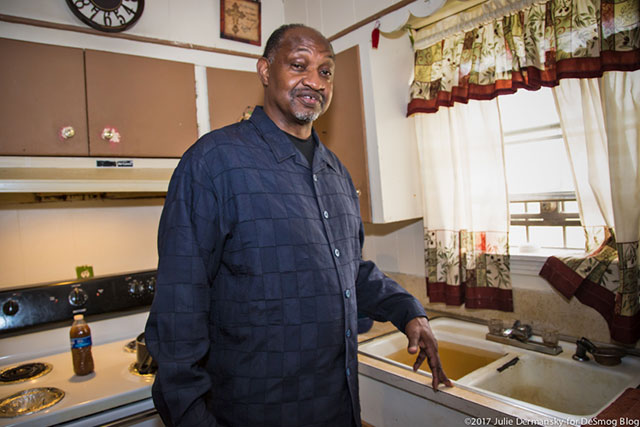 Roy Bowman fills his sink to show the color of the water that the Bowmans receive at their home in St. Joseph. (Photo: Julie Dermansky)
Roy Bowman fills his sink to show the color of the water that the Bowmans receive at their home in St. Joseph. (Photo: Julie Dermansky)
“The water here has been bad for at least eight years,” Roy Bowman said, “but getting anyone to do anything about it was impossible until Flint’s situation was in the news.”
St. Joseph’s water crisis stems from a 90-year-old system that hasn’t been properly maintained, a problem that is not uncommon in other towns in Louisiana and elsewhere. While the water crisis in Flint was caused by an ill-advised decision to switch the city’s water supply to the Flint River, corroding their aging lead pipes, the resulting health emergency was the same.
Before lead was detected, St. Joseph’s water tested positive for high levels of iron and magnesium, which causes the discoloration. Until the governor declared a health emergency, residents were told by State Health Officer Dr. Jimmy Guidry that the water was safe to drink, though the Bowmans told me that no one they knew was drinking it.
Last year, before lead was found, Bowman offered Guidry water from his home. Guidry declined, acknowledging that drinking discolored water was not desirable.
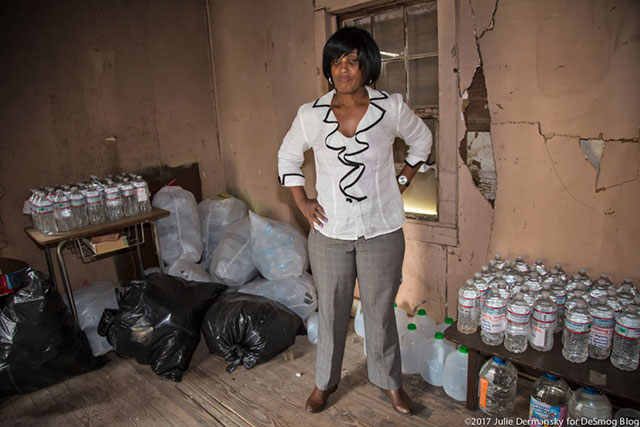 Wanda Bowman keeps clean water handy in a shed on the Bowmans’ property to distribute to those who need it. (Photo: Julie Dermansky)
Wanda Bowman keeps clean water handy in a shed on the Bowmans’ property to distribute to those who need it. (Photo: Julie Dermansky)
Wanda Bowman doesn’t think the water was safe to drink or wash with before the health emergency declaration, and doesn’t believe the potable water now being provided via tanks is safe to drink either, though it is being tested daily. She is not alone. Everyone she knows is sticking to bottled water.
It saddens her that people with so little money have been spending so much to buy water, despite paying water bills too. But she pointed out that not drinking the town’s water for so long might have prevented people’s health from being compromised.
The state has offered blood tests to pregnant women and children under age six. As of March 13, all of the blood work has tested negative for lead, according to Robert Johannessen, communications director for the Louisiana Department of Health.
New Water System Likely Won’t Be Quick Fix for All
Once the new system is operational, Louisiana plans to retest homes that previously tested positive for lead to determine if the pipes connecting the municipal line to residences will also require replacement. Many of those pipes are just as old as the town’s lines, but those replacements will be the responsibility of the buildings’ owners.
According to the governor’s office, for those who can’t afford it, “the state is working to see what partnerships are available from other sources, such as the [US Department of Agriculture], to help provide some grant or loan assistance to qualified residents with repayment ability.”
The residents I spoke to expressed gratitude that the town’s water system is being replaced, but no one thinks the obligation to continue paying water bills in full is fair. “I’m not looking for something for nothing,” Lee Richardson told me after revealing the brown water that pours into his kitchen sink and bathtub. “I just don’t like paying for dirty water.”
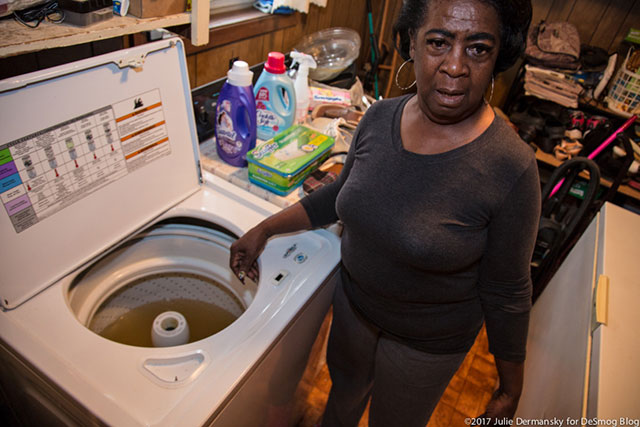 St. Joseph resident Rudy Shorts fills her washing machine to see if the water is usable and opts not to use it. (Photo: Julie Dermansky)
St. Joseph resident Rudy Shorts fills her washing machine to see if the water is usable and opts not to use it. (Photo: Julie Dermansky)
In response to this point, the governor’s office said via email:
“The Governor certainly understands the frustration that comes from paying a water bill, but getting a product that can’t be used as intended. No one wants to be in that situation. But, he reminds people that’s why — even before the lead situation was found — that he has worked to help the town get the funding necessary to rebuild the water system and bring the community, safe, clean water. He also reminds people the system can only be maintained in the future with all residents paying their bills today and in the years to come.”
During the groundbreaking ceremony, Gov. Edwards made it clear that the people in St. Joseph are lucky: “The simple fact of the matter is we can’t replicate this effort around the state because we don’t have enough money.”
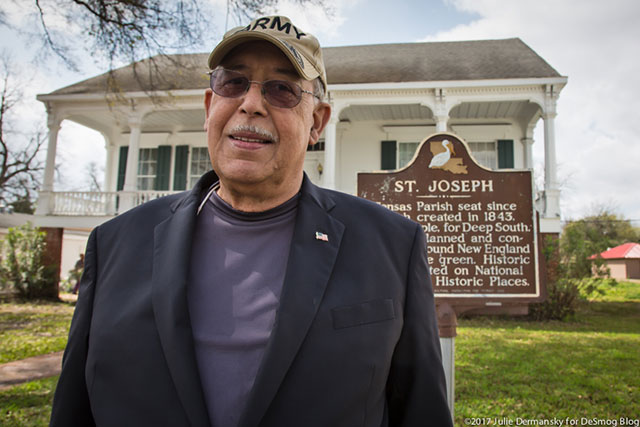 General Russel Honoré of GreenArmy was in St. Joseph for the groundbreaking ceremony for the new water system. (Photo: Julie Dermansky)
General Russel Honoré of GreenArmy was in St. Joseph for the groundbreaking ceremony for the new water system. (Photo: Julie Dermansky)
General Honoré, who has been advocating for the people of St. Joseph, agrees the state can’t possibly afford to reproduce the town’s costly fix in up to 50 other small Louisiana towns he hears are also dealing with dirty water.
“Clean water is a human right,” he said, but in order to provide it, he thinks current systems of water delivery need to be transformed. Honoré suggested smaller towns’ water systems be consolidated into larger regional systems.
The American Society of Civil Engineers’ report card for US infrastructure also suggests systemic change is needed. The society gave the country a D on drinking water infrastructure.
Federal help available to states for upgrading water systems is a drop in the bucket compared to what is needed across the country.
Last year the Environmental Protection Agency (EPA) released an outline of actions to improve the safety and reliability of the nation’s drinking water. But with the Trump administration’s proposed massive budget cuts for the EPA, it is doubtful the agency will have the money or the will to carry out those plans effectively or enforce key regulations that protect drinking water.
While the EPA announced on January 10 $1 billion will be available as loans for water infrastructure projects, the agency has estimated that the US needs about $660 billion in investments for drinking water, wastewater, and stormwater infrastructure improvements over the next 20 years.
For perspective, the United States has one million miles of drinking water infrastructure, and 12 of those miles are now being replaced in St. Joseph.
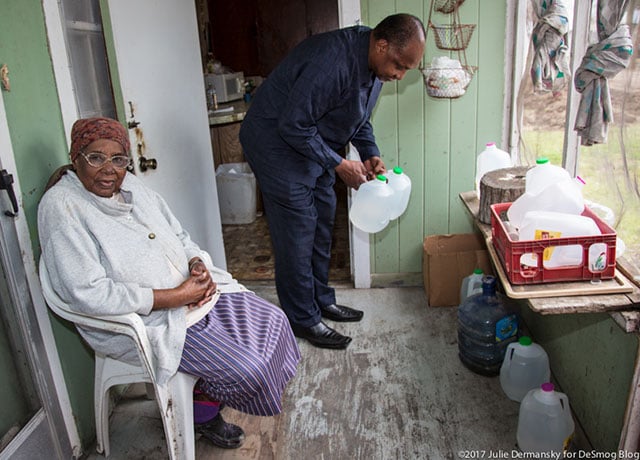 Roy Bowman delivering clean water to Viola Marshall, one of the elders in town he and his wife make sure have water on a regular basis. (Photo: Julie Dermansky)
Roy Bowman delivering clean water to Viola Marshall, one of the elders in town he and his wife make sure have water on a regular basis. (Photo: Julie Dermansky)
Until their town’s water system is fixed, the Bowmans plan to continue delivering water to those who don’t have the means to get it for themselves. Filling up jugs and delivering the water “is a lot of work,” Wanda said, but she doesn’t want to see the town elders cutting back on their water intake because they are afraid of running out. “No one in America should have to live that way.”
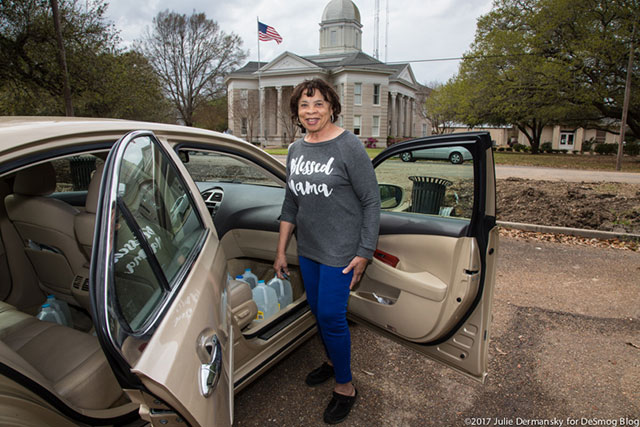 Mamie Fields, wife of St. Joseph’s mayor, filling up gallon jugs with water provided by the state of Louisiana. (Photo: Julie Dermansky)
Mamie Fields, wife of St. Joseph’s mayor, filling up gallon jugs with water provided by the state of Louisiana. (Photo: Julie Dermansky)
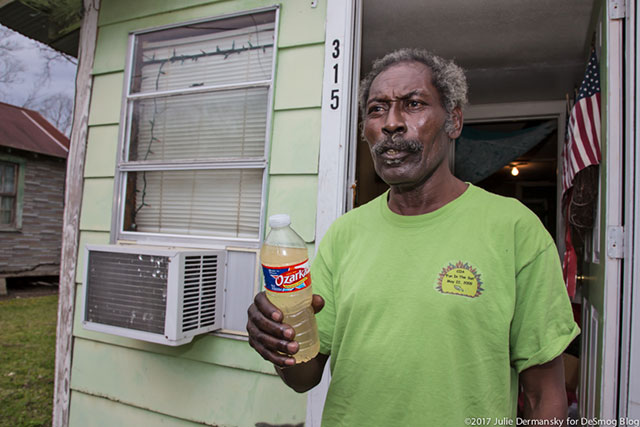 Eddie Sanders holds a bottle he filled at home to show the poor condition of his tap water. (Photo: Julie Dermansky)
Eddie Sanders holds a bottle he filled at home to show the poor condition of his tap water. (Photo: Julie Dermansky)
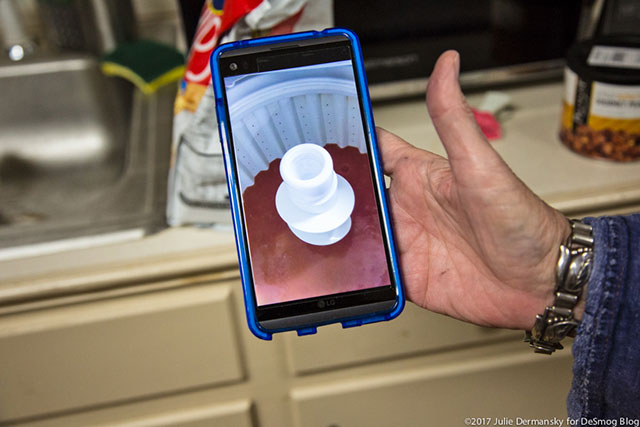 Valerie Sloan with a photo of the water that came out of the St. Joseph municipal water system when she tried to use her washing machine. (Photo: Julie Dermansky)
Valerie Sloan with a photo of the water that came out of the St. Joseph municipal water system when she tried to use her washing machine. (Photo: Julie Dermansky)
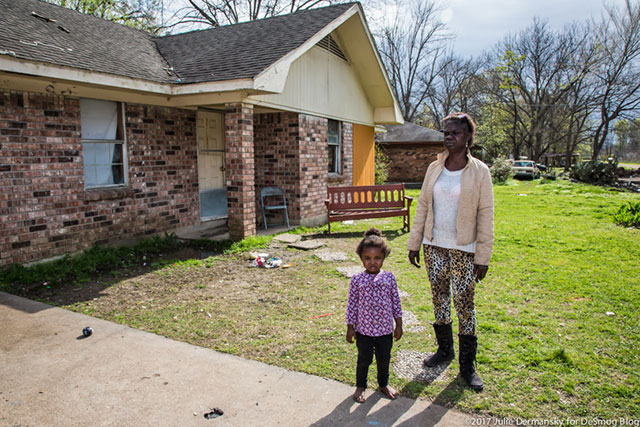 Maxine Washington, here with one of her grandchildren, wishes the tanks providing clean water were closer to her home. (Photo: Julie Dermansky)
Maxine Washington, here with one of her grandchildren, wishes the tanks providing clean water were closer to her home. (Photo: Julie Dermansky)
*Louisiana Environmental Action Network donated 1,104 one gallon containers to residents so they would have vessels to use when retrieving clean water provided to to St. Joseph by the state.
Truthout Is Preparing to Meet Trump’s Agenda With Resistance at Every Turn
Dear Truthout Community,
If you feel rage, despondency, confusion and deep fear today, you are not alone. We’re feeling it too. We are heartsick. Facing down Trump’s fascist agenda, we are desperately worried about the most vulnerable people among us, including our loved ones and everyone in the Truthout community, and our minds are racing a million miles a minute to try to map out all that needs to be done.
We must give ourselves space to grieve and feel our fear, feel our rage, and keep in the forefront of our mind the stark truth that millions of real human lives are on the line. And simultaneously, we’ve got to get to work, take stock of our resources, and prepare to throw ourselves full force into the movement.
Journalism is a linchpin of that movement. Even as we are reeling, we’re summoning up all the energy we can to face down what’s coming, because we know that one of the sharpest weapons against fascism is publishing the truth.
There are many terrifying planks to the Trump agenda, and we plan to devote ourselves to reporting thoroughly on each one and, crucially, covering the movements resisting them. We also recognize that Trump is a dire threat to journalism itself, and that we must take this seriously from the outset.
After the election, the four of us sat down to have some hard but necessary conversations about Truthout under a Trump presidency. How would we defend our publication from an avalanche of far right lawsuits that seek to bankrupt us? How would we keep our reporters safe if they need to cover outbreaks of political violence, or if they are targeted by authorities? How will we urgently produce the practical analysis, tools and movement coverage that you need right now — breaking through our normal routines to meet a terrifying moment in ways that best serve you?
It will be a tough, scary four years to produce social justice-driven journalism. We need to deliver news, strategy, liberatory ideas, tools and movement-sparking solutions with a force that we never have had to before. And at the same time, we desperately need to protect our ability to do so.
We know this is such a painful moment and donations may understandably be the last thing on your mind. But we must ask for your support, which is needed in a new and urgent way.
We promise we will kick into an even higher gear to give you truthful news that cuts against the disinformation and vitriol and hate and violence. We promise to publish analyses that will serve the needs of the movements we all rely on to survive the next four years, and even build for the future. We promise to be responsive, to recognize you as members of our community with a vital stake and voice in this work.
Please dig deep if you can, but a donation of any amount will be a truly meaningful and tangible action in this cataclysmic historical moment.
We’re with you. Let’s do all we can to move forward together.
With love, rage, and solidarity,
Maya, Negin, Saima, and Ziggy